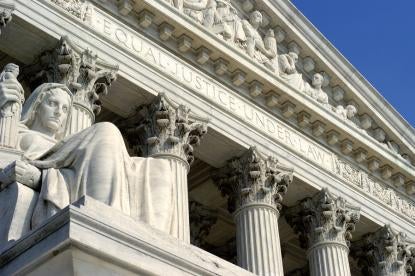Please revisit Don Chisum’s and Janice Mueller’s comments on Impression Products v. Lexmark, No. 151189 (S. Ct. May 30, 2017), in which the Court held that a seller of a patented printer cartridge had exhausted its patent rights, so that a “refurbisher” could obtain the empty cartridges from the original buyers, re-fill them with toner, and sell them (again). The Court held that the patentee’s rights to sue the infringer had been exhausted when they made the first sale, even though it sold cartridges only after the buyer agreed to not resell or refurbish them for further use. (I am using the term the Court used: “refurbish” and you will see why.)
Remarkably, this decision did not cite three earlier Supreme Court decisions that dealt with situations in which the patentees’ rights were held not to be exhausted by the first sale, leaving me to wonder if the decisions were “good law” post-Lexmark.
These decisions, Aro Mfg. v. Convertible Top Replacement Co., 365 U.S. 336 (1961)(“Aro I”), American Cotton Tie Co. v. Simmons, 106 U.S. 80 (1892), J.E.M. Ag Supply v. Pioneer Hi-Bred Int’l, Inc., 534 U.S. 124 (2001) and Bowman v. Monsanto Co., No. 11-796 (S. Ct., May 13, 2013). A full copy of Bowman can be found in one of my earlier posts that you can access under Agricultural Biotech in this site’s archive. In it, Justice Kagan discusses the other three decisions. Aro I also discusses American Cotton Tie.
In each of these decisions, the Court held that the patentee’s right to sue a party post-sale for infringement did not exhaust its patent rights. Aro I articulated the “repair” vs. “reconstruct” rule for deciding if a convertible owner, or the company that sold him/her fabric to replace the original fabric part of the top, infringed a patent on the top mechanism. The fabric was not patented, but that did not control the outcome of the case, which was that the convertible owner was simply repairing his car.
The Aro I Court relied on early precedent, including Wilson v. Simpson, (U.S.) 9 How, 109, 13 L.Ed. 66 in which the purchaser of a planning machine bought new cutting knives when the original ones wore out. The Wilson Court explained that it is “the use of the whole” of the combination which a purchaser buys, and that repair or replacement of the worn-out, damaged or destroyed part is but an exercise of the right “to give duration to that which he owns or has a right to use as a whole.”
The Court might have concluded that this is what the buyer of the empty toner cartridge did in Impression Products. Wasn’t refilling the cartridge with toner a permissible repair of the cartridge? We are simply told by the Impression Court that all the patentee’s rights were exhausted upon the first sale of the cartridge, period. But are they?
In Cotton-Tie, JEM and Bowman, the patentees’ right to sue for infringement – forget any asserted licensor rights—was held to be intact after the first sale had occurred. In Cotton-Tie, the patented devise was a series of metal straps with buckles, to hold cotton bales together. The straps were cut off by the buyer of the cotton and sold as scrap metal. Simmons bought the fragments, including the buckles, repaired the damage and resold the bands. The Court distinguished Wilson v. Simpson, as “not amounting to a reconstruction of the machine,” and held that “Because the defendants prepare and sell the [cotton tie], composed of the buckle or link and the band, intending to have it used to bale cotton and to produce the results set forth in the [patents], they infringe those patents.” Here, there was no “repair” but, rather, full-fledged reconstruction.
Reconstruction, in the form of replication, was also the key fact in finding the defendants liable for infringement in both J.E.M. Ag Supply and Bowman. The defendant farmer realized that the soybean seeds purchased and stored in a grain elevator and intended for processing, were mostly patented transgenic Monsanto seeds that had been engineered to be glyphosate resistant, since most of the farmers in his area were buying Monsanto’s seeds. Bowman bought seeds from the grain elevator, planted them, selected for glyphosate resistance and replanted some of the glyphosate-resistant seeds to raise a second crop.
Monsanto sued him for patent infringement.
Bowman raised patent exhaustion as a defense, arguing that Monsanto could not control his use of the soybeans because they were the subject of a prior authorized sale (from local farmers to the grain elevator). The Supreme Court agreed with the Federal Circuit that lithe [patent exhaustion] doctrine restricts a patentee’s rights only as to the ‘particular article sold’ … it leaves untouched the patentee’s ability to prevent a buyer from making new copies of the patented item. ‘[T]he purchaser of the [patented] machine … does not acquire any right either for his own use or to be vended to another.’ Wilbur-Ellis Co. v. Kuther, 377 U.S. 422 (1964)(holding that a purchaser’s ‘reconstruction’ of a patented machine ‘would impinge on the patentee’s right ‘to exclude others from making’ … the article.'” After discussing Aro I, Justice Kagan continued:
“Under the patent exhaustion doctrine, Bowman could resell the patented soybeans he purchased from the grain elevator; so too he could consume the beans himself or feed them to his animals. Monsanto, although the patent holder, would have no business interfering in those uses of Roundup Ready beans…but the exhaustion doctrine does not enable Bowman to make additional patented soybeans without Monsanto’s permission (either express or implied)… Because Bowman thus reproduced Monsanto’s patented invention, the exhaustion doctrine does not protect him.”
The Bowman decision also discussed J.E. M. for the proposition that a patent holder could prohibit “a farmer who legally purchases and plants” a protected seed from saving harvested seed “for replanting”. Kagan writes:
“That statement is inconsistent with applying exhaustion to protect conduct like Bowman’s” … Reproducing a patented article no doubt “uses’ it after a fashion. But … we have always drawn the boundaries of the exhaustion doctrine to exclude that activity, so that the patentee retains an undiminished right to prohibit others from making the thing his patent protects [citing Cotton-Tie Co.] … [i]f simple copying were a protected use, a patent would plummet in value after the first sale of the first item containing the invention… Hence, our repeated rule that exhaustion applies only to the particular item sold, and not to reproductions… Bowman planted Monsanto’s patented soybeans solely to make and market replicas of them, this depriving the company of the reward patent law provides for the sale of each article. Patent exhaustion provides no haven for that conduct.”
In view of the fact that in Impression Products, the Supreme Court stated that, “Once a patentee sells an item, it has ‘enjoyed all the rights secured by that limited monopoly.”‘ it seems only fair to ask whether or not the exhaustion doctrine still offers patentees protection in case of reconstruction of a simple mechanical device or of a self-replicating plant or other bio- or robotic device. It would have been easy for the court to contrast the “repair” of toner cartridges with the “reconstruction” of the soybeans in Bowman or the corn plants in J.E.M. but if the intent of the Court was to eliminate these distinctions and overrule more than a century of precedent, the Impression Products Court owed us all at least a footnote.



 i
i


